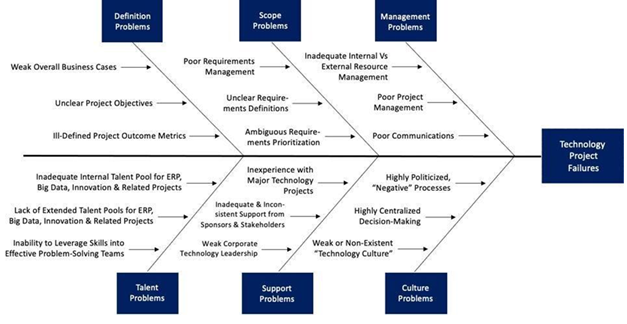It might be hard to believe, but only 35 percent of projects undertaken worldwide are successful. According to Nieto-Rodriguez, A. (2021), we are wasting time, money, and opportunity on projects that are consistently failing. The problem exists across various industries with similar findings on project failure echoed by Matta, N., & Ashkenas, R. (2019), H., E., & E., O. (2014), and Andriole, S. (n.d.), to name a few.
Clearly, many companies are struggling with this problem. A variety of factors can affect the outcome of a project, ranging from the size of the project(s) — and thus their complexity — to the emergence of new business problems that may require heavy research and development (R&D). Scarcity of required skills in the market can also contribute to a lack of success, as do external factors such as new government policies or regulations.
So how do we go about improving the performance and success rate of the projects in which we are involved?
In the fishbone below, Andriole, S. (n.d.) highlights 6 reasons IT projects fail. Andriole recommends investing as much effort as possible in addressing the top three reasons: definition, scope, and management problems, adding that the bottom three: talent, support, and culture problems are essentially unsolvable. The latter is debatable and beyond the scope of this article. However, we can look at the problem areas of definition, scope, and management and identify some of the things we can do differently to improve.

More often than not, I find favourable outcomes are achieved by returning to the basic fundamental principles of project management. Let’s explore one critical knowledge area of project management; communication, which Andriole, S. (n.d.) highlights as a contributing factor to project failure.
Communication 101
You will likely agree that communication tops the list of project problem points. When poorly done, communication affects the quality of work and also impacts our professional and personal relationships. Clearly, communication is a critical aspect of successful project delivery and demands our attention.
The Basics:
For any type of communication to occur, we require the following:
- Sender (source): The person who initiates the communication.
- Receiver (destination): The person who receives the information from the sender.
- Message: Data/information that enables the person receiving it to become aware of the subject of communication and possibly take action.
- Medium (channel of communication): A reliable channel of communication that the receiver has access to in order to be able to respond back. This channel may be email or a shared project management platform like Jira or Asana.
Sivasankari, R. (2010)
It’s one thing to send information from the source to the destination and vice versa, but for effective communication to occur, we need to incorporate feedback loops in our communication. Feedback loops ensure that information is getting through to the right people in a timely manner and that the people receiving the information can interpret the purpose of the communication. There’s nothing worse than communication that goes unanswered: it can disrupt and weaken the foundations of trust between the parties involved. It is therefore imperative that project teams maintain a sense of urgency with every thread of communication until closure.
Practical steps
Sender
When you send a message, it’s good practice to:
- Write messages that are clear, easy to understand, and not ambiguous. Achieve this by following the 5Ws (What, Why, Who, Where, When) and 1H (How).
- Ensure that the message clearly states what the receiver should do with the information.
- Follow up with the receiver and check that the message has arrived.
- Follow up to check if the receiver has understood the message in the context it has been shared. This is an opportunity to clarify any misunderstanding on the part of the receiver and control the scope of requirements to avoid scope creep.
Receiver
When you receive a message, it’s good practice to:
- Respond to the sender and acknowledge the message has been received. The sooner you do this, the better, as it removes the need for the sender to follow up and check if the message has been received. I recommend aiming to send an acknowledgement of receipt of communication within 24hrs. It is even better if you can respond in full within this timeframe.
- Get on a phone call with the sender to discuss any questions relating to the information received. The tendency to become keyboard warriors only creates room for further confusion through the back-and-forth email responses. It is a waste of time. Dialogue typically resolves many issues quickly.
- Advise the next immediate step(s) in response to the message and also provide an estimated timeline for when the sender can expect the required action(s) to be completed.
- Follow up with the sender to ensure the response is clear and then check if the communication can be closed off by asking the sender if there’s anything else they require.
I know the above steps may seem simple. These are the basic fundamental principles of effective communication that we likely already know about. However, if you take a closer look into your communication channels within your projects, you’ll be shocked to find how many team members don’t take the initiative to follow up and follow through on communications with clients and or team members. As a result, projects often struggle due to the following reasons:
- Hanging communications due to lack of call to action (CTAs)
- Delayed responses, which can expand project schedules. Making up for lost time may require project crashing and additional resources mean increased project cost.
- Hindered flow of critical information to the right people can create gaps in understanding requirements. This can lead to missed opportunities to better understand business problems and create sustainable solutions at a reduced cost.
I strongly recommend and encourage you to put into practice the above practical steps. You will be amazed at the results it brings for your clients, teams, and your overall project performance. Bear in mind this is not the only area that we can work on to increase the likelihood of project success. However, you have to start somewhere, and what better place than communication.
References
Andriole, S. (n.d.). 3 Main Reasons Why Big Technology Projects Fail – & Why Many Companies Should Just Never Do Them. Forbes. Retrieved June 23, 2022, from https://www.forbes.com/sites/steveandriole/2021/03/25/3-main-reasons-why-big-technology-projects-fail—why-many-companies-should-just-never-do-them/?sh=61418253257c
H., E., & E., O. (2014). Project failure factors and their impact on the construction industry: A literature review. The International Conference on Civil and Architecture Engineering, 10(10), 1–20. https://doi.org/10.21608/iccae.2014.44191
Matta, N., & Ashkenas, R. (2019, April 4). Why Good Projects Fail Anyway. Harvard Business Review. https://hbr.org/2003/09/why-good-projects-fail-anyway
Nieto-Rodriguez, A. (2021, October 18). The Project Economy Has Arrived. Harvard Business Review. https://hbr.org/2021/11/the-project-economy-has-arrived
Sivasankari, R. (2010). Art of communication in project management. Pmi.org. https://www.pmi.org/learning/library/effective-communication-better-project-management-6480
Unsplash. (2019). Gaining a deep understanding the prob… | HD photo by Headway (@headwayio) on Unsplash. Unsplash.com; Unsplash. https://unsplash.com/photos/5QgIuuBxKwM





